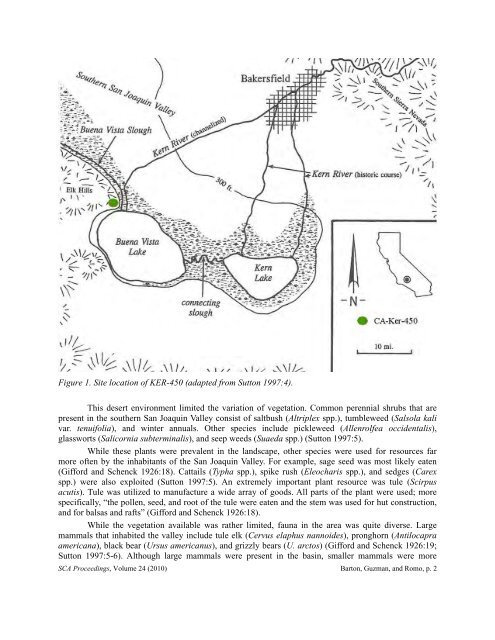at the bead hill site - Society for California Archaeology
at the bead hill site - Society for California Archaeology
at the bead hill site - Society for California Archaeology
You also want an ePaper? Increase the reach of your titles
YUMPU automatically turns print PDFs into web optimized ePapers that Google loves.
Figure 1. Site loc<strong>at</strong>ion of KER-450 (adapted from Sutton 1997:4).<br />
This desert environment limited <strong>the</strong> vari<strong>at</strong>ion of veget<strong>at</strong>ion. Common perennial shrubs th<strong>at</strong> are<br />
present in <strong>the</strong> sou<strong>the</strong>rn San Joaquin Valley consist of saltbush (Altriplex spp.), tumbleweed (Salsola kali<br />
var. tenuifolia), and winter annuals. O<strong>the</strong>r species include pickleweed (Allenrolfea occidentalis),<br />
glassworts (Salicornia subterminalis), and seep weeds (Suaeda spp.) (Sutton 1997:5).<br />
While <strong>the</strong>se plants were prevalent in <strong>the</strong> landscape, o<strong>the</strong>r species were used <strong>for</strong> resources far<br />
more often by <strong>the</strong> inhabitants of <strong>the</strong> San Joaquin Valley. For example, sage seed was most likely e<strong>at</strong>en<br />
(Gif<strong>for</strong>d and Schenck 1926:18). C<strong>at</strong>tails (Typha spp.), spike rush (Eleocharis spp.), and sedges (Carex<br />
spp.) were also exploited (Sutton 1997:5). An extremely important plant resource was tule (Scirpus<br />
acutis). Tule was utilized to manufacture a wide array of goods. All parts of <strong>the</strong> plant were used; more<br />
specifically, “<strong>the</strong> pollen, seed, and root of <strong>the</strong> tule were e<strong>at</strong>en and <strong>the</strong> stem was used <strong>for</strong> hut construction,<br />
and <strong>for</strong> balsas and rafts” (Gif<strong>for</strong>d and Schenck 1926:18).<br />
While <strong>the</strong> veget<strong>at</strong>ion available was r<strong>at</strong>her limited, fauna in <strong>the</strong> area was quite diverse. Large<br />
mammals th<strong>at</strong> inhabited <strong>the</strong> valley include tule elk (Cervus elaphus nannoides), pronghorn (Antilocapra<br />
americana), black bear (Ursus americanus), and grizzly bears (U. arctos) (Gif<strong>for</strong>d and Schenck 1926:19;<br />
Sutton 1997:5-6). Although large mammals were present in <strong>the</strong> basin, smaller mammals were more<br />
SCA Proceedings, Volume 24 (2010) Barton, Guzman, and Romo, p. 2
















